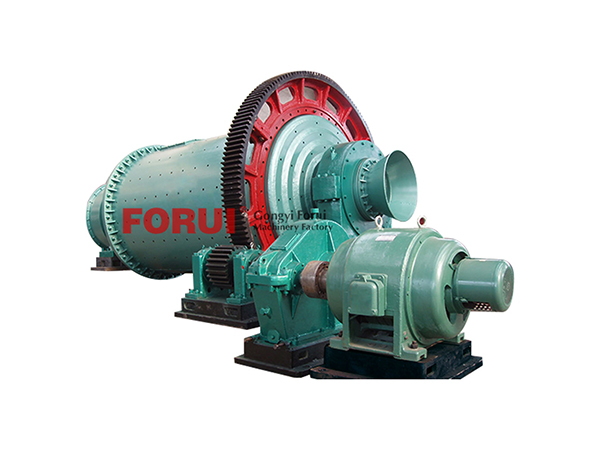Brief Introduction of Ball Mill
Ball mill is the key equipment for grinding after the crushing process in the beneficiation plant, it is used to grind kinds of materials such as copper ore, gold ore, magnetite ore, quartz, lead zinc ore, feldspar and other materials into fine powder 20-75 micrometer.
Introduction of Ball Mill
Ball Mill is a type of grinder used to grind materials into an extremely fine powder mainly for use in the mineral processing industry. Ball Mills can grind various ores and other materials either wet or dry, depending on requirements. Ball Mills consist of a large cylinder which slowly rotates around a horizontal axis.

The Application of Ball Mill
Ball mill is a key equipment to grind the crushed materials, and the ball mill is widely used in powder-making production line including cement, silicate, new-type building material, refractory material, fertilizer, ore dressing of ferrous metal and non-ferrous metal, glass ceramics, etc. And the ball mill can grind various ores and other materials with dry type and wet type. There are two kinds of ball mill, grid type and overflow type due to different ways of discharging material.
Working Principle of Ball Mill
A ball mill consists of a hollow cylindrical shell rotating about its axis. The axis of the shell may be either horizontal or at a small angle to the horizontal. It is partially filled with balls. The grinding media is the balls, which may be made of steel(chrome steel), stainless steel, ceramic, or rubber. The inner surface of the cylindrical shell is usually lined with an
abrasion-resistant material such as manganese steel or rubber. Less wear takes place in rubber lined mills. The length of the mill is approximately equal to its diameter.

In case of continuously operated ball mill, the material to be ground is fed from the left through a 60° cone and the product is discharged through a 30° cone to the right. As the shell rotates, the balls are lifted up on the rising side of the shell and then they cascade down (or drop down on to the feed), from near the top of the shell. In doing so, the solid particles in between the balls and ground are reduced in size by impact.
Technical Parameter of Ball Mill
| Model | Shell rotation speed(r/min) | Ball load(t) | Feeding size(mm) | Discharging size(mm) | Capacity(t/h) | Motor power(kw) | Weight(t) |
| Ø 900*1800 | 36-38 | 1.5 | < 20 | 0.075-0.89 | 0.65-2 | 18.5 | 4.6 |
| Ø 900*3600 | 36 | 2.7 | < 20 | 0.075-0.89 | 1.1-3.5 | 22 | 5.6 |
| Ø 1200*2400 | 36 | 3 | < 25 | 0.075-0.6 | 1.5-4.8 | 30 | 12 |
| Ø 1200*3600 | 36 | 3.5 | < 25 | 0.074-0.4 | 1.6-5 | 37 | 12.8 |
| Ø 1200*4500 | 32.4 | 5 | < 25 | 0.074-0.4 | 1.6-5.8 | 55 | 13.8 |
| Ø 1500*3600 | 29.7 | 7.5 | < 25 | 0.074-0.4 | 2.0-5.0 | 75 | 15.6 |
| Ø 1500*4500 | 27 | 11 | < 25 | 0.074-0.4 | 3.0-5.0 | 110 | 21 |
| Ø 1500*5700 | 28 | 12 | < 25 | 0.074-0.4 | 3.5-6 | 130 | 24.7 |
| Ø 1830*3600 | 25.4 | 11 | < 25 | 0.074-0.4 | 4.0-10.0 | 130 | 28 |
| Ø 1830*4500 | 25.4 | 15 | < 25 | 0.074-0.4 | 4.5-12 | 155 | 32 |
| Ø 1830*6400 | 24.1 | 21 | < 25 | 0.074-0.4 | 6.5-15 | 210 | 34 |
| Ø 1830*7000 | 24.1 | 23 | < 25 | 0.074-0.4 | 7.5-17 | 245 | 36 |
| Ø 2100*3600 | 23.7 | 15 | < 25 | 0.074-0.4 | 6.5-36 | 155 | 34 |
| Ø 2100*4500 | 23.7 | 24 | < 25 | 0.074-0.4 | 8-43 | 245 | 42 |
| Ø 2100*7000 | 23.7 | 26 | < 25 | 0.074-0.4 | 8-48 | 280 | 50 |
| Ø 2200*4500 | 21.5 | 27 | < 25 | 0.074-0.4 | 9-45 | 280 | 48.5 |
| Ø 2200*6500 | 21.7 | 35 | < 25 | 0.074-0.4 | 14-26 | 380 | 52.8 |
| Ø 2200*7000 | 21.7 | 35 | < 25 | 0.074-0.4 | 15-28 | 380 | 54 |
| Ø 2200*7500 | 21.7 | 35 | < 25 | 0.074-0.4 | 15-30 | 380 | 56 |
| Ø 2400*3600 | 21 | 23 | < 25 | 0.074-0.4 | 7-50 | 245 | 54 |
| Ø 2400*4500 | 21 | 30 | < 25 | 0.074-0.4 | 8.5-60 | 320 | 65 |
| Ø 2700*4000 | 20.7 | 40 | < 25 | 0.074-0.4 | 12-80 | 400 | 94 |
| Ø 2700*4500 | 20.7 | 48 | < 25 | 0.074-0.4 | 12-90 | 430 | 102 |

